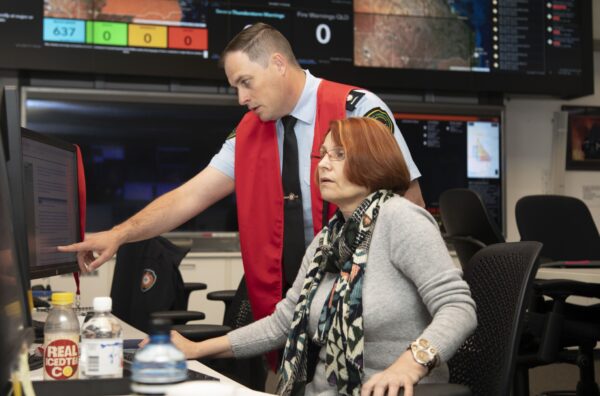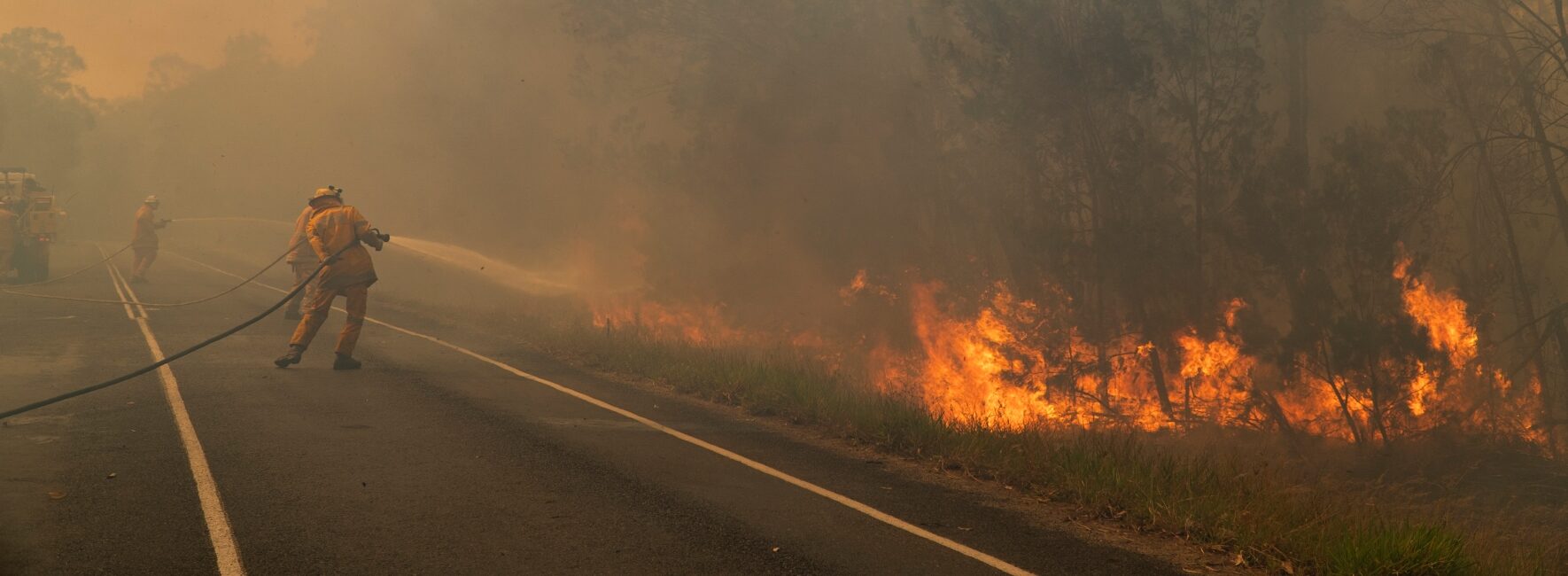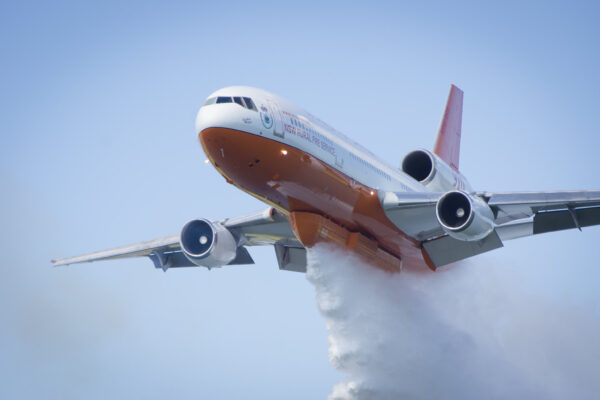The warnings were delivered by Professor Emeritus David Karoly, a former UN climate change author and internationally recognised for his work, and Greg Mullins, a former Fire and Rescue NSW commissioner and founder of Emergency Leaders for Climate Action, and NSW grazier Peter Lake.
Prof Karoly is at pains to explain that the ability to predict the location, rainfall or movement of tropical cyclones is extremely difficult for computer modelling and even for experienced forecasters.
“They are certainly chaotic and can be affected and not predicted well,” he says of tropical cyclones like Alfred.
“We even saw that with Alfred as it moved towards Brisbane. The speed of movement slowed down even though it was predicted to hit the coastline earlier.”
He says the Bureau of Meteorology’s forecasting capability has been partly hampered by staffing cutbacks since the introduction of so-called efficiency dividends of 1.25 per cent annually back in 1987.
“Those cutbacks have led to effectively 30 to 40 per cent reductions in standard bureau operational funding,” Prof Karoly says.
The unpredictability of weather events is another problem.
“Cutbacks in staff are really important but even with more staff, the perfect model cannot yet predict tropical cyclone tracks, locations of thunderstorms and amount of rainfall,” he says.
“So we have chaos as the dominant uncertainty. It’s a bit like a poo stick and predicting where the stick is going to be in the river. It’s just as bad as that in terms of predicting rainfall amounts and locations of storms. “
He also points out that as the oceans warm up globally, tropical cyclones will range further north away from the equator as in towards the Northern Hemisphere.
US CUTBACKS
When asked by NewsCop about the impact of the Trump administration’s funding and staffing cuts to scientific bodies like NOAA and FEMA, Prof Karoly first started with an explanation about the role played by the World Meteorological Organisation (WMO).
He explains that under the WMO, all weather forecasting and data collection agencies in every country across the world agree to share their data.
“The WMO (193 member states and territories) certainly has as many members as the United Nations,” he says.
“They’ve all agreed to share their data because weather doesn’t respect national borders.”
He explains that the National Oceanic Atmospheric Administration (NOAA) is the host agency for the US National Weather Service, National Hurricane Centre and National Severe Storms Laboratory.
They provide data from global weather analysis modelled in the US as well as providing data sets from satellites that record temperatures, rainfall and radar data, and provide these to all countries.
Australia’s Bureau of Meteorology receives data from NOAA, US National Weather Service and other countries satellite data for ocean temperatures and weather observation.
“If there is a charge for that data that Donald Trump wants to impose, it would restrict the capabilities in Australia,” Prof Karoly says.
“But staffing cuts have already been imposed on NASA, NOAA and the National Weather Service. These agencies have lost staff.”
He remains uncertain about the longer-term effects that the US cutbacks will mean for the sharing of data or, potentially, paying for data sets from the US.
“There have, of course, been long-term small cutbacks — not the instantaneous massive cutback happening in the US — but essentially death by 100 cuts,” Prof Karoly points out.
“The 1.25 per cent efficiency dividend that was started in 1987 and continues today leads to cutbacks in operational budgets in the Bureau of Meteorology, CSIRO and in many other science agencies around Australia, including the Australian Antarctic Division.”

GREG MULLINS
For former Fire and Rescue NSW boss Greg Mullins, it’s a close call between what will be Australia’s next disaster – another cyclone popping up where it shouldn’t or the Coalition winning the next federal election.
“I have to say it fills me with horror that we have a federal election coming up and we could get a government (with) the same people who mismanaged the Black Summer response and the early 2022 floods,” he says.
“We need a government like we saw in this event (Tropical Cyclone Alfred); it was a very slick operation,” he says.
“States and the federal government working together co-operatively (and the) early activation of the Australian Defence Force which is a whole other story because it detracts from defence of our nation but that’s what climate change is doing more and more.”
Mullins points out that the slick preparation will be needed because “we won’t always have the amount of warning that we had on this occasion”.
“We can’t afford to see our premier science organisations like CSIRO gutted again,” he says in reference to last year’s cull of 500 jobs which has been described as a threat to research at the time.
Mullins expects worse to come if Opposition Leader Peter becomes PM and follows through on a pledge to cut the public service by 36,000 jobs as he seeks to imitate the job-cutting in the US.
“The Bureau of Meteorology has been gutted, in my view, and can no longer provide forecasts as comprehensive as they used to; that impacts people like me who are out on the fireground and in the floods because the accuracy of the forecasts aren’t where they should be,” Mullins says.
“If we go to this election and think, ‘oh let’s go back to the other mob’ … they don’t have a plan for climate and they don’t have a plan for emergency management.”
On the possible pending loss of scientific/meteorological capability, Mullins says it can prove to be a life-and-death call – literally.
BURNT BY MODELLING
He points to a hazard burn held across Sydney’s Northern Beaches last October as an example of the risks involved in relying on computer modelling.
The burn was held in heavy thick scrub but the winds were much stronger than forecast and the fire got away from crews. The result was emergency warnings and “many, many homes” suddenly in danger because of a lack of forecasters in Sydney due to an over-reliance on modelling to provide forecasts.
“It should have been picked up but we got something from a model and it was wrong. We had fires in the scrub (and it was) saying ‘benign conditions’. The fires had gone pyroconvective, which means they form their own thunderstorm that can kill people,” Mullins explains.
“I’m really fearful of this coming election. The Coalition have already said they’re going to cut the public service; I think it’ll be more of the same.”
He says the country can’t afford a return to a decade of cuts to the CSIRO and climate science work.
“We can’t afford to go back to that because that’s our eyes and ears. What’s going to happen in the future? Farmers must know; firefighters must know, SES volunteers must know.”
LITANY OF DISASTERS
Mullins refers to a recent litany of disasters both in Australia and worldwide as “unnatural” disasters especially compared to what he experienced in the first 30 years of his career.
“I don’t think they’re natural (disasters) because they’re nothing in like my early career. They’re just becoming more intense. They’re cumulative.”
He highlights the floods in Lismore in 2023, the Black Summer bushfires (2019), Townsville floods (2018) and 2022, more bushfires in 2023 and 2024, more floods in Townsville again this year and now Tropical Cyclone Alfred.
He believes Brisbane dodged a bullet with TC Alfred although areas like Harvey Bay may disagree.
The impact of large weather events is also mental especially when it comes to first responders: “a lot of us are still suffering from what we saw in Black Summer and our narrow escapes on many occasions, thinking ‘well, we’re not coming home’ and seeing death and destruction on a scale we haven’t had to deal with before,” he says.
“Mental health impacts the fatigue as volunteers have to leave their places of work sometimes for months and lose their income because states are being hit simultaneously a lot of the time.”
And it is likely to get worse, nationally and internationally
“We have simultaneous events; they’re becoming far more common. We haven’t got the assistance and it’s the same internationally,” Mullins says.
He points to the availability of big firefighting aircraft (Large Air Tanker or LAT) based overseas as a case in point.
“We lease most of them from the US and Canada. If they’re going to get winter fires, they’re not going to release those aircraft in future so we’ll have a big hole in our firefighting capability.”
TOMORROW: Storm brewing for businesses who fail to account for climate risks








